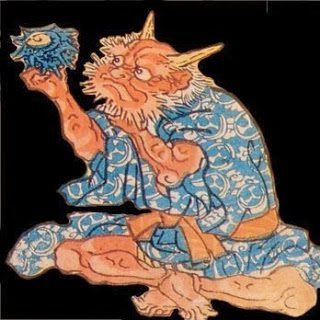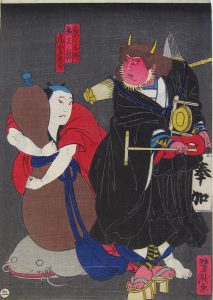Art of Japan and Yoshitaki: Oni Demon, Namazu, and Japanese Culture
Lee Jay Walker
Modern Tokyo Times
Utagawa Yoshitaki (1841-1899) produced several stunning pieces of art related to the oni demon. In the main image in this article called the Oni Demon and Catfish you have two very powerful forces at play. Therefore, the individual in this image faces the wrath of the giant catfish and the clutches of the powerful oni which is intent on collecting souls to take to the pits of hell.
In Japanese folklore, the powerful writhing of a giant catfish (namazu) was bad news based on mythology. Thenamazu is a harbinger of devastation when breaking free from the god Kashima.
Therefore, when the namazu escapes from the clutches of Kashima terrible devastating forces are unleashed. These brutal forces apply to potent earthquakes and tsunamis which kill untold numbers. In the world of ukiyo-e, the namazu and oni were popular subjects to focus on when highlighting Japanese folklore in the Edo and Meiji periods of history. After all, the oni and namazu are great storytellers and the reality that Japan is blighted by tsunamis, earthquakes, typhoons, and other potent natural forces; means that in the old world of mystery, it did appear that demonic forces were at play.
The role of the oni in the folklore of Japan is very potent because when the gates of hell are opened then the power of this demon comes into play for people who have done “dark deeds” in this world. Japanese artists in the Edo period clearly highlight the oni and the same applies to Japanese literature and kabuki. Therefore, Yoshitaki in his art piece titled Oni Demon and Catfish is putting the person in the scene in a terrible dilemma.
Toshidama Gallery comments about this print: “This print tells a complex narrative. The figure on the left holds a giant gourd – this was known to be one of the few magical ways to quell the much feared catfish which in the print is lying compliantly underneath. The legends of Japan say that earthquakes and tsunamis are caused by the writhing of a giant catfish (namazu) under Fuji. There were popular prints of the quelling of the catfish (Namazu-e) which appeared after natural disasters such as the Ansei earthquake of 1855.”
In this stunning image by Yoshitaki, it is clear that the namazu appears unconcerned by the individuals attempt to quell the power it holds according to Japanese folklore. The oni on the other hand looks angry and powerful. It could just be that the namazu knows that the oni is too much for this brave individual who is trying to stop calamity from happening. Therefore, an almost like smirk face persists on the namazu and it could be that theoni is impatient because he wants to collect souls to take to the pits of hell.
Of course, an image by itself is always open to major interpretation but sometimes singular images can be more potent because of this fact. According to some individuals, the catfish actually does behave strangely before natural disasters. This fact means that the god Kashima must be alert at all times according to Japanese folklore but sadly the namazu can’t be contained indefinitely because just like the oni, the namazu is extremely cunning.
https://twitter.com/Toshidama TOSHIDAMA GALLERY
Please visit http://toshidama.wordpress.com for more articles and information.
Please visit http://toshidama-japanese-prints.com/ – On our site you will see a wonderful selection of Japanese woodblock prints for sale. Ukiyo-e (the Japanese name for woodblock prints of the 18th and 19th centuries) are beautiful, collectible and a sound financial investment.
http://www.toshidama-japanese-prints.com/item_428/Yoshitaki-Oni-Demon-and-Catfish.htm
Modern Tokyo News is part of the Modern Tokyo Times group
http://moderntokyotimes.com Modern Tokyo Times – International News and Japan News
http://sawandjay.com Modern Tokyo Times – Fashion
https://moderntokyonews.com Modern Tokyo News – Tokyo News and International News
http://global-security-news.com Global Security News – Geopolitics and Terrorism
PLEASE JOIN ON TWITTER
https://twitter.com/MTT_News Modern Tokyo Times
PLEASE JOIN ON FACEBOOK
https://www.facebook.com/moderntokyotimes
Some Japanese art and cultural articles by Modern Tokyo Times are republished in the need to highlight the unique traits of this nation to our growing international readership.


